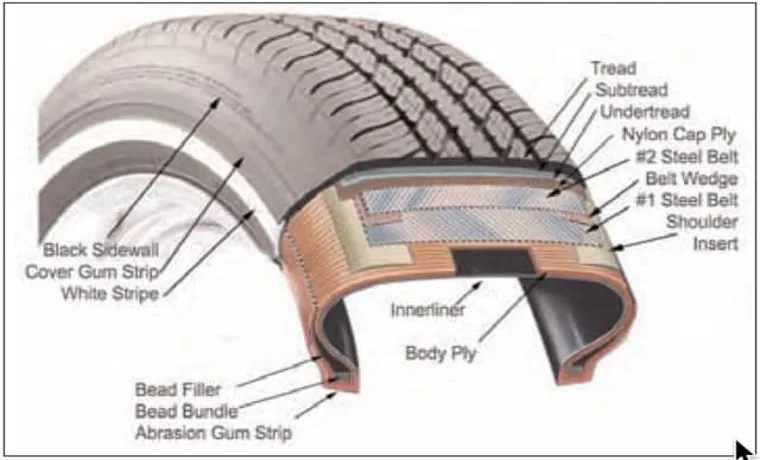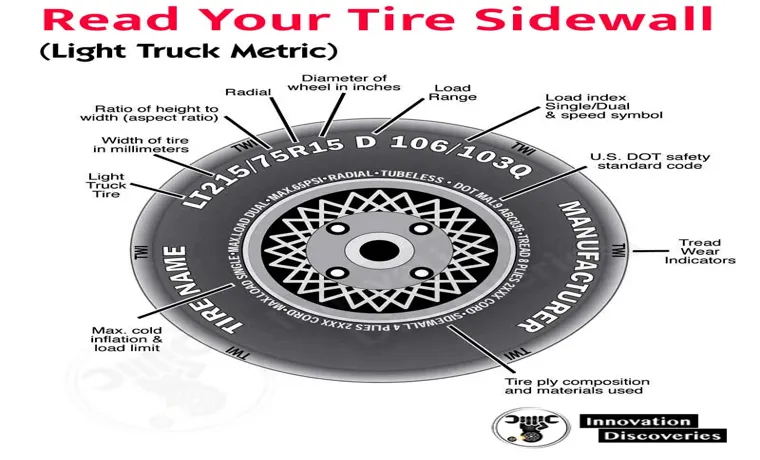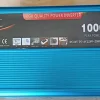Have you ever wondered what the sidewall of a tire actually is? You know, that part of the tire that’s covered in numbers, letters, and branding. It may seem like just another random feature of a tire, but in reality, it plays a crucial role in the performance and safety of your vehicle. The sidewall of a tire is the vertical section that runs between the tread and the bead, which sits on the rim.
It’s made of sturdy rubber and is responsible for maintaining the shape and strength of the tire. Additionally, it serves as a protective layer against curbs, potholes, and other road hazards. But it’s not just its physical makeup that makes the sidewall so crucial.
Tire manufacturers also use the sidewall to convey important information about the tire. For example, you’ll find the tire size, load capacity, speed rating, and other specs printed on the sidewall. This information is vital for ensuring that you choose the right tires for your vehicle and that you use them safely and effectively.
So, the next time you’re inspecting your tires or shopping for new ones, don’t overlook the sidewall. It may just be a small aspect of your vehicle, but it plays a huge role in keeping you safe on the road.
Table of Contents
Anatomy of a Tire’s Sidewall
The sidewall of a tire contains important information that is necessary for properly maintaining and using your tires. It typically includes the tire brand and model, size and load capacity, as well as the recommended tire pressure, maximum speed, and load index. However, one piece of information that is not located on the sidewall of a tire is the tire’s tread depth.
Although this is a critical factor in determining the tire’s condition and performance, it is not required to be displayed on the sidewall. Instead, it is recommended that you regularly check your tire’s tread depth using a tire tread gauge or visually inspecting the tire. Proper tire maintenance, including monitoring tread depth, can help prolong the life of your tires and ensure your safety while driving.
Tire Size
When it comes to tires, the size can make quite a difference. To understand a tire’s size, it’s important to look at its sidewall. The sidewall is the part of the tire that faces outwards, and it’s where you’ll find all the information you need to determine the tire’s size, type, and other important details.
One of the first things you’ll notice on a tire’s sidewall is a series of numbers and letters. This is known as the tire’s “size code.” The size code includes numbers that indicate the tire’s width, aspect ratio, and diameter.
For example, a tire with a code of P215/65R15 would have a width of 215 millimeters, an aspect ratio (which is the height of the tire’s sidewall as a percentage of its width) of 65 percent, and a diameter of 15 inches. Understanding these numbers can help you choose the right tire for your vehicle and ensure optimal performance and safety on the road.

Tire Brand and Model
When it comes to tires, the brand and model can play a critical role in determining the performance and suitability of the tire for different driving conditions. The sidewall of a tire can provide essential information about the brand, model, size, and type of tire. The tire brand is usually displayed prominently at the top of the sidewall and can help a driver quickly identify the make of the tire when they need to replace it.
The tire model is typically located just below the brand name and can provide details on the specific type of tire within the brand’s lineup. It may include features such as the tread design, speed rating, load index, and intended use. Understanding the information listed on the sidewall can help drivers make informed decisions when choosing a tire brand and model that will perform well for their particular driving requirements.
Tire Construction Type
Tire Construction Type One critical part of a tire that often goes unnoticed is the sidewall. It may look like a simple layer extending from the bead to the tread, but it contains essential information about a tire’s construction type. The sidewall can tell you whether a tire is bias-ply or radial, its aspect ratio, and load carrying capacity, among other things.
The tire type affects performance, durability, and handling, so it’s crucial to understand the anatomy of a tire’s sidewall before making a purchase. Knowing the construction type of a tire and its limits can help ensure a safer and more comfortable ride. Remember, it’s not all about the tread when it comes to tire performance.
Give those sidewalls a closer look next time!
Load Index and Speed Rating
When it comes to tires, there is much more than meets the eye. One crucial aspect of a tire’s sidewall is the load index and speed rating. The load index indicates the maximum weight a tire can carry, with higher numbers translating to a greater weight capacity.
Meanwhile, the speed rating indicates the maximum speed a tire can handle, with higher letters indicating a greater capability. These ratings are essential to ensure that your vehicle is both safe and performing at its best, as using a tire with a lower rating than necessary can result in potential hazards, including blowouts, decreased handling, and reduced fuel economy. Therefore, when purchasing new tires, double-check your vehicle manual to ensure that the tire’s load index and speed rating is a suitable match, keeping in mind that each vehicle model requires a specific rating to ensure top performance.
What is NOT on a Tire’s Sidewall?
When it comes to tire sidewalls, there are several pieces of information that are typically listed, from the tire size to the maximum load capacity and speed rating. However, there are a few pieces of information that are not typically found on a tire’s sidewall. So, which of the following is not located on the sidewall of a tire? The answer is the tire’s date of manufacture.
This information is actually found on the tire’s bead, which is the inner edge that fits onto the wheel. The date of manufacture is important to know because tires can degrade over time, even if they have plenty of tread remaining. Ideally, you should replace your tires every six years, even if they still look good.
If you’re not sure how old your tires are, look for the four-digit number that’s stamped into the bead. The first two digits represent the week of the year that the tire was made, and the second two digits represent the year. So, if you see “2418” stamped into the bead, that means the tire was made in the 24th week of 201
Tire Pressure
Tire Pressure Have you ever taken a closer look at your car’s tire sidewall and wondered what all those numbers and markings mean? While the information on a tire’s sidewall can be useful for choosing the right size and type of tire for your vehicle, there are some important details that are not listed. For example, you won’t find the recommended tire pressure on the sidewall. Maintaining the correct tire pressure is crucial for both safety and performance, as underinflated tires can lead to poor handling and decreased fuel efficiency while overinflated tires can cause blowouts and uneven wear.
To find the correct tire pressure for your car, you’ll need to consult your owner’s manual or the sticker located inside the driver’s side door jamb. It’s important to check your tire pressure regularly and adjust it as needed to ensure a safe and comfortable ride.
Tire Tread Depth
When it comes to tire maintenance, understanding the importance of tire tread depth is essential. Proper tread depth ensures that your tires have good traction on the road, which is essential for safety and performance. However, there are some things that you can’t find on a tire’s sidewall, such as the actual tread depth.
While the tire size, load rating, and maximum pressure are all clearly marked on the sidewall, tread depth must be measured manually. Using a tread depth gauge, you can measure the depth of your tire’s tread and determine if it’s time for replacement. Remember to check your tire’s tread depth on a regular basis, and always replace your tires before they become too worn.
By doing so, you’ll stay safe on the road and enjoy optimal performance from your vehicle.
Tire Alignment Information
Tire alignment is a crucial aspect of vehicle maintenance that plays a significant role in your car’s overall performance. However, it’s worth noting that not all information about your car’s tires can be found on their sidewalls. While the tire sidewall contains crucial data, such as the tire’s size, manufacturer, and DOT code, it doesn’t provide information on the tire’s alignment requirements.
Proper tire alignment ensures that your car drives smoothly, maximizes fuel efficiency, and extends the tire’s lifespan. Typically, tire alignment is required every two to three years or if you notice any unusual tire wear or steering issues. Therefore, to ensure that your car is operating optimally, have your tire alignment checked regularly by a professional mechanic.
Conclusion
In the pursuit of excellence and attention to detail, a common knowledge among car enthusiasts is to inspect every part of their vehicle, including the sidewalls of their tires. However, in the vast majority of cases, one crucial thing that you won’t find on a tire’s sidewall is its owner’s sense of humor. So, while your tires might exceed your expectations, don’t expect them to match your comedic prowess.
“
FAQs
What is the purpose of the sidewall on a tire?
The sidewall on a tire provides information about the tire’s size, type, and maximum inflation pressure.
What is the function of a tire’s tread?
The tire tread provides grip and traction on the road, improving the vehicle’s handling and braking.
How often should you check your tire pressure?
It is recommended to check your tire pressure at least once a month or before a long trip.
Can you drive on a tire with a puncture?
It is not recommended to drive on a tire with a puncture, as it can lead to further damage and potentially a blowout.
What is the difference between summer tires and winter tires?
Summer tires are designed for warm weather conditions and provide better handling and performance, while winter tires are designed for cold temperatures and provide better traction on snow and ice.
What is a tire’s load index?
A tire’s load index refers to the maximum weight that a tire can support when properly inflated.
Which of the following is not located on the sidewall of a tire?
The tire’s speed rating is not located on the sidewall of a tire, but on the tire’s tread.



